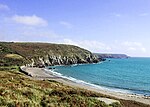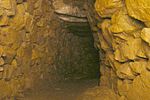The Lizard

The Lizard (Cornish: An Lysardh) is a peninsula in southern Cornwall, England, United Kingdom. The most southerly point of the British mainland is near Lizard Point at SW 701115; Lizard village, also known as The Lizard, is the most southerly on the British mainland, and is in the civil parish of Landewednack, the most southerly parish. The valleys of the River Helford and Loe Pool form the northern boundary, with the rest of the peninsula surrounded by sea. The area measures about 14 by 14 miles (23 km × 23 km). The Lizard is one of England's natural regions and has been designated as a National Character Area 157 by Natural England. The peninsula is known for its geology and for its rare plants and lies within the Cornwall Area of Outstanding Natural Beauty (AONB).The Lizard's coast is particularly hazardous to shipping and the seaways round the peninsula were historically known as the "Graveyard of Ships" (see below). The Lizard Lighthouse was built at Lizard Point in 1752 and the RNLI operates The Lizard lifeboat station.
Excerpt from the Wikipedia article The Lizard (License: CC BY-SA 3.0, Authors, Images).The Lizard
Geographical coordinates (GPS) Address Nearby Places Show on map
Geographical coordinates (GPS)
| Latitude | Longitude |
|---|---|
| N 50.033333333333 ° | E -5.1833333333333 ° |
Address
Grade-Ruan
, Grade-Ruan
England, United Kingdom
Open on Google Maps











